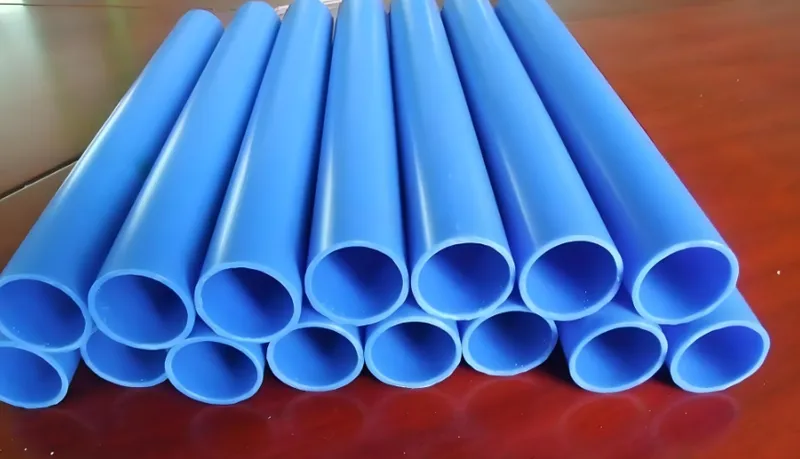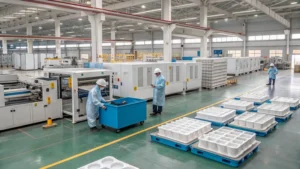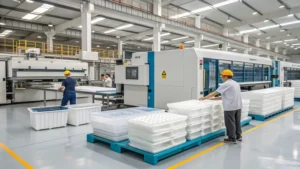
Plastic extrusion1 is a cost-effective, high-volume manufacturing process that produces continuous profiles like pipes and sheets, distinguishing it from other methods such as injection molding, which excels at crafting complex 3D parts like toys and medical devices.
Plastic extrusion creates long, uniform shapes like pipes and window frames, offering cost efficiency for high-volume production, while injection molding is ideal for intricate, discrete components.
Choosing the right manufacturing process is critical for optimizing cost, complexity, and application suitability. This blog post dives into how plastic extrusion stacks up against injection molding, blow molding, thermoforming, and rotational molding, providing actionable insights for your next project.
Plastic extrusion is faster for long, uniform shapes.True
Extrusion operates continuously, speeding up production of long profiles compared to batch processes like injection molding.
Injection molding is always more expensive than extrusion.False
While injection molding involves higher initial tooling costs, it can be more economical for complex parts in large volumes.
- 1. What is Plastic Extrusion and How Does it Compare to Other Processes?
- 2. When to Use Plastic Extrusion Over Other Processes?
- 3. How Does the Plastic Extrusion Process Work?
- 4. What Materials Are Compatible with Plastic Extrusion?
- 5. How to Choose Between Plastic Extrusion and Other Processes?
- 6. What Are the Related Technologies to Plastic Extrusion?
- 7. Conclusion
What is Plastic Extrusion and How Does it Compare to Other Processes?
Plastic extrusion involves melting thermoplastic materials and forcing them through a die to form continuous profiles with a consistent cross-section—think pipes, tubes, and sheets. Widely utilized in construction, packaging, and automotive sectors, it shines for its efficiency in producing uniform, linear products. In contrast, processes like injection molding are tailored for detailed, three-dimensional items.
Plastic extrusion melts thermoplastics to form continuous profiles like pipes, while injection molding crafts discrete, complex parts like toys, with extrusion being more cost-effective for high-volume, uniform shapes.

Definitions and Core Principles
-
Plastic Extrusion: A continuous process where plastic pellets are melted in a heated barrel, extruded through a die, and cooled to create long shapes like pipes and window frames.
-
Injection Molding2: A batch process injecting molten plastic into a mold to produce precise, complex parts such as toys and automotive components.
-
Blow Molding: Forms hollow items like bottles by inflating a molten plastic tube inside a mold.
-
Thermoforming3: Shapes heated plastic sheets over a mold, ideal for trays and packaging.
-
Rotational Molding: Rotates a mold with plastic powder to form large, hollow objects like tanks.
Classification of Processes
| Process | Product Type | Material | Application |
|---|---|---|---|
| Extrusion | Continuous profiles | Thermoplastics (PVC, PE, PP) | Pipes, sheets, window frames |
| Injection Molding | Discrete, complex parts | Thermoplastics, thermosets | Toys, medical devices |
| Blow Molding | Hollow objects | Thermoplastics (PET, HDPE) | Bottles, containers |
| Thermoforming | Sheet-based products | Thermoplastic sheets (PET, PVC) | Trays, packaging |
| Rotational Molding | Large, hollow parts | Polyethylene | Tanks, playground equipment |
Plastic extrusion is limited to simple shapes.True
Extrusion excels at uniform cross-sections, while complex geometries favor injection molding.
All plastic manufacturing processes use the same materials.False
Material suitability varies; rotational molding typically uses polyethylene, unlike extrusion’s broader range.
When to Use Plastic Extrusion Over Other Processes?
Plastic extrusion shines in high-volume production of continuous profiles, offering unmatched cost efficiency and speed, whereas injection molding suits complex, discrete parts requiring precision.
Opt for plastic extrusion for long, uniform shapes like pipes and window frames, and injection molding for detailed parts like toys and medical devices.

Typical Application Scenarios
-
Plastic Extrusion:
- Construction: Pipes, window profiles.
- Packaging: Films, sheets.
- Automotive: Cables, seals.
-
Injection Molding:
- Consumer Goods: Toys, electronics housings.
- Medical: Syringes, implants.
- Automotive: Dashboards, fittings.
-
Blow Molding: Beverage bottles, fuel tanks.
-
Thermoforming: Food trays, blister packs.
-
Rotational Molding: Water tanks, playground slides.
Pros and Cons Comparison
| Aspect | Plastic Extrusion | Injection Molding |
|---|---|---|
| Cost | Lower tooling costs, ideal for high volumes | Higher tooling costs, suits complex parts |
| Product Complexity | Uniform cross-sections only | Intricate 3D shapes possible |
| Production Speed | Continuous, fast for profiles | Batch, quick for individual parts |
| Material Waste | Minimal, reusable | Some waste from sprues |
| Strength | May be weaker due to orientation | Stronger, isotropic |
| Surface Finish | Often needs finishing | Excellent straight from mold |
| Design Flexibility | Limited to linear profiles | High for complex designs |
Plastic extrusion is more cost-effective than injection molding for high volumes.True
Its continuous nature minimizes downtime, reducing costs for large runs of uniform profiles.
Injection molding cannot produce long profiles.True
It’s designed for discrete parts, not continuous shapes like extrusion.
How Does the Plastic Extrusion Process Work?
Plastic extrusion transforms thermoplastic pellets into continuous profiles by melting them, pushing them through a die, and cooling them into shape.
Plastic extrusion melts pellets, extrudes them through a die to form profiles like pipes, and cools them for use in construction, packaging, and automotive applications.

Process Workflow Breakdown
-
Feeding: Plastic pellets enter a hopper.
-
Melting: A rotating screw melts the pellets in a heated barrel.
-
Shaping: Molten plastic is extruded through a die to form the profile.
-
Cooling: The shape solidifies in a water bath or air cooling system.
-
Cutting: The continuous profile is trimmed to length.
Key Parameters
-
Temperature: Influences melt flow and consistency.
-
Screw Speed: Affects pressure and processing time.
-
Die Design: Defines the profile’s shape and precision.
-
Cooling Rate: Ensures dimensional accuracy and finish.
Temperature control is critical in plastic extrusion.True
Precise temperatures prevent defects like warping by ensuring consistent melt flow.
All plastics can be extruded at the same temperature.False
Each plastic, like PVC versus PP, has a unique melt temperature range.
What Materials Are Compatible with Plastic Extrusion?
Plastic extrusion predominantly uses thermoplastics such as PVC, PE, PP, and ABS, with material choice impacting flexibility, strength, and cost.
Commonly extruded thermoplastics include PVC for pipes, PE for films, PP for packaging, and ABS for automotive parts.

Material Impact on Process
-
PVC: Affordable, used for pipes; needs careful heat management.
-
PE: Flexible, ideal for films; supports recycled inputs.
-
PP: Strong, suited for packaging; requires higher melt temperatures.
-
ABS: Durable, used in automotive; excels in complex profiles.
Material Comparison Table
| Material | Melt Temperature (°C) | Applications | Notes |
|---|---|---|---|
| PVC | 160-210 | Pipes, window frames | Avoids degradation with care |
| PE | 120-180 | Films, bags | Recyclable |
| PP | 160-240 | Packaging, textiles | Stronger than PE |
| ABS | 200-250 | Automotive, electronics | Complex shape capability |
Recycled plastics can be used in extrusion.True
Extrusion accommodates recycled materials, though quality may vary with impurities.
All thermoplastics are equally suitable for extrusion.False
Differences in melt flow and stability affect their extrusion performance.
How to Choose Between Plastic Extrusion and Other Processes?
The choice hinges on product shape, production volume4, complexity, and budget constraints.
Select plastic extrusion for continuous profiles like pipes, and injection molding for complex, discrete parts like toys.

Design Checklist for Extrusion
-
Ensure a uniform cross-section.
-
Match material melt flow to die requirements.
-
Plan cooling to avoid distortion.
-
Define tolerances along the extrusion axis.
-
Anticipate post-processing needs like cutting.
Decision-Making Guide
-
Choose Extrusion if:
-
You need long, continuous products (e.g., pipes).
-
High volumes demand cost efficiency.
-
The design is simple and uniform.
-
-
Choose Injection Molding if:
-
You require complex, discrete parts (e.g., toys).
-
Precision and finish are paramount.
-
Volume justifies tooling investment.
-
-
Other Processes:
-
Blow Molding: Hollow items like bottles.
-
Thermoforming: Sheet products like trays.
-
Rotational Molding: Large hollow parts like tanks.
-
Extrusion is always the cheapest option.False
While tooling costs are lower, injection molding may be cheaper for complex parts at scale.
Extrusion can produce complex 3D shapes.False
It’s restricted to 2D profiles; 3D complexity requires molding.
What Are the Related Technologies to Plastic Extrusion?
Plastic extrusion links to upstream resin production and downstream assembly, with related processes like blow molding and thermoforming enhancing its ecosystem.

Upstream: Resin production5; Downstream: Assembly, finishing; Related: Blow molding6, thermoforming, rotational molding.
Upstream Technologies
-
Resin Production: Converts raw materials into plastic pellets.
-
Compounding: Adds properties via additives.
Downstream Processes
-
Assembly: Integrates extruded parts with others.
-
Finishing: Includes cutting or coating.
-
Recycling: Reuses scrap material.
Related Processes
-
Blow Molding: Uses extruded parisons for hollow items.
-
Thermoforming: Shapes extruded sheets.
-
Rotational Molding: Competes for large hollow parts.
Extrusion is the only process for producing plastic pipes.False
Rotational molding can also produce large-diameter pipes.
Extrusion and injection molding use the same equipment.False
Extrusion uses continuous screws; injection molding uses reciprocating systems.
Conclusion
Plastic extrusion stands out as a cost-effective, high-speed option for continuous profiles like pipes and sheets, ideal for high-volume needs. Injection molding, however, takes the lead for complex, precise 3D parts, despite higher upfront costs. Blow molding, thermoforming, and rotational molding cater to niche applications—hollow objects, sheet products, and large hollow parts, respectively. Evaluate your project’s shape, volume, material, and budget to select the optimal process, ensuring efficiency and quality in your manufacturing journey.
-
Explore this link to understand the benefits of plastic extrusion, including cost efficiency and production speed, crucial for your projects. ↩
-
Discover insights on injection molding's unique advantages and applications, helping you choose the right process for your needs. ↩
-
Learn about thermoforming's process and its uses in creating various products, enhancing your knowledge of manufacturing techniques. ↩
-
Understanding production volume can help optimize manufacturing strategies and improve cost efficiency. ↩
-
Understanding resin production is crucial for grasping the entire plastic extrusion process, from raw materials to finished products. ↩
-
Exploring blow molding will enhance your knowledge of how hollow plastic items are created, a key aspect of the extrusion ecosystem. ↩








